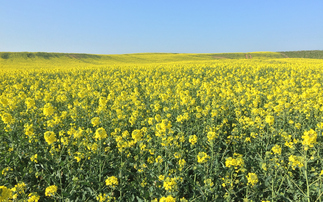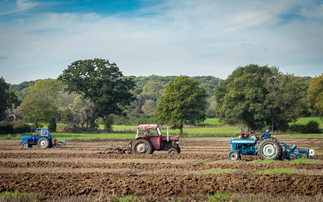A new report aims to help businesses and the public measure and reduce their use of key natural resources
I began and ended my term as Europe's Environment Commissioner by warning that the 21st Century will be the century of fragility. In a world where the global population is growing at a staggering rate, where consumption continues to grow and where natural resources are finite, the fragility of our economy is inextricably linked to the fragility of the environment. The one is dependent on the other, something which business leaders with an anxious eye on volatile resource prices and input costs are increasingly aware.
The key to navigating this fragility is resource efficiency. We need to produce more while using fewer resources. Or, to put it another way, we must reduce our environmental footprint - i.e., tread lightly. But how can we tread more lightly if we have no idea what load we're carrying, that load being our demand for natural resources including land and water?
Over the last few years we've seen a growing number of companies, governments and members of the public pledging to make, use and do more with less. That's the good news - awareness is improving. But the truth is we are still very much locked into the linear economic model that developed over centuries of seemingly abundant resources - one in which we extract resources, use them with abandon and finally discard them as waste, without maximising their use. To ensure continual wellbeing for our citizens we need to transform our economies from a linear model which worked during an age of abundance to a streamlined circular model fit for the age of fragility and interdependence.
In the circular economy everybody plays their part to get resources back into circulation as secondary raw materials. Governments provide infrastructure, incentives and, if needed, regulation, while businesses ensure their products and business models are designed for reuse and recycling and minimise the use for resources in the first place. Individuals, who after all don't design the products they buy and aren't responsible for setting up recycling infrastructure or tax and subsidy regimes, can then focus on what they are responsible for: their own behaviour.
During my tenure the Environment Commission committed to developing a set of indicators that would enable us to measure Europe's resource efficiency. Working with partners across the EU Institutions, Member States, business leaders, academics and NGOs, we proposed the adoption of indicators for material use, land use, water use, biodiversity and greenhouse gas emissions, and a resource efficiency target that would be based on Gross Domestic Product divided by Raw Material Consumption.
Together we understood that the EU's future industrial competitiveness will depend on using fewer raw materials, less energy and less water, and on our ability to replace raw materials and imports with supplies of secondary raw materials, while designing and producing goods that can be re-used, repaired, refurbished and recycled.
The measure of our success will be that we have separated economic growth and increasing human wellbeing on the one hand from natural resource consumption on the other. While continuing to improve the wealth and wellbeing of our citizens we must learn how to halt and then reverse what has up to now been a pattern of consistent growth in demand for resources. Environmental fragility and competition from rapidly growing new economies such as the BRICS countries means we have no choice.
So, governments, companies and the public need to play their parts. But how can anyone be sure they're becoming more resource efficient if they don't know how much they're consuming to start with? This is why the Mind Your Step report from Friends of the Earth and Trucost is so useful.
Trucost has looked at a number of household products and estimated how much land and water is required to produce them, and to sustain some of the companies that make and market them. These estimates are based on financial flows between sectors and so represent generic, rather than specific, products, but nonetheless they give a striking insight into what's needed to make the stuff we use every day. Nearly thirteen tonnes is a surprisingly large weight of water for that smartphone in your pocket. An area the size of Belgium for one company to make chocolate and confectionary really underlines the dependence that our companies and economies have on precious and finite resources, and the risks and vulnerability that come with that.
Having a large land or water footprint, or being a large consumer of any other natural resource, doesn't imply any value judgement about the efficiency of a company. It could be that that company is simply the most successful, selling the most products. But it does given an indication of the company's exposure to that fragility I mentioned earlier. By measuring its dependence on natural resources throughout the value chain, and identifying where the ‘hot spots' of high resource use are, a company can take informed decisions about how to focus its efforts to become more resource efficient.
The Mind Your Step report makes some interesting suggestions for where these hotspots lie too. It highlights the significant land requirement for packaging across the range of products, and the significant contribution to water demand that pollution at the production and assembly phases makes to the tech sector's overall water footprint. It also shows what happens when a supply chain is poorly managed. Water use for a pair of leather boots doubles when, as sadly happens, there is a failure to properly treat the effluent discharged from tanneries.
This approach of measuring demand for natural resources through the supply chain is at the heart of what we were trying to do with the European Commission's resource efficiency agenda. Our proposed Raw Material Consumption target and the wider dashboard of the land, water, materials and greenhouse gas indicators is relevant for all sectors of the economy. Taking into account the full value-chain, including imported goods and materials helps boost the resource efficiency of our products, companies and economies. It also supports our reindustrialisation goal by ensuring that policy makers consider the full 'rucksack' of materials needed for their production.
There is no substitute for real data based on the experience and characteristics of actual products and companies, but in the meantime estimates provided in the Mind Your Step report are extremely useful reminders of how heavily we currently tread on the world. More than that, in a world of fragile economies and environments, they are signposts to how we can tread more lightly, while continuing to grow our economies and improve the wellbeing of our citizens.
Dr Janez Potočnik is the former European Commissioner for Environment and current co-chair of UNEP International Resource Panel







